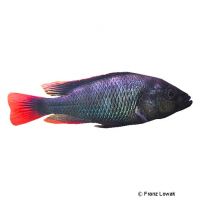Blue Victoria Mouthbrooder (Haplochromis nubilus)
| Blue Victoria Mouthbrooder Haplochromis nubilus | |
|---|---|
| Name | Blue Victoria Mouthbrooder |
| Name Lat. | Haplochromis nubilus |
| Synonym | Astatotilapia nubila |
| Family | Cichlids |
| Family lat. | Cichlidae |
| Order | Cichlids |
| Order lat. | Cichliformes |
| Origin | Lake Victoria |
| Habitat | Lake, tributaries |
| Diet | Omnivore |
| pH | 7.0-9.0 |
| Behavior | Aggressive |
| Keeping | Harem |
| Care Level | Moderate |
| Reproduction | Mouthbrooder |
| Breeding | Simple |
| Life Span | 3-5 years |
| Protection | No |
| Metric Units | |
| Size | 10-13 cm |
| Temperature | 21-29 °C |
| Hardness | 4-10 °dH |
| Aquarium | 120 cm / 240 l |
| US Units | |
| Size | 3.9"-5.1" |
| Temperature | 70-84 °F |
| Hardness | 71-178 ppm |
| Aquarium | 65 gal |
Distribution and habitat
The distribution area of the incandescent coal mouthbrooders is the entire Lake Victoria basin in Uganda, Kenya and Tanzania. They live on the vegetated, shallow shores of the lakes and in their inflows and outflows.
Maintenance
The aquarium should have a border planting with many hiding places from stones and roots and offer sufficient swimming space. A substrate of sand or fine gravel and slightly alkaline, medium-hard water is ideal.
No ammonia, ammonium and nitrite should be detectable, the nitrate value should not exceed 100 mg/l. To ensure the water quality and oxygen content, a filter and heater adapted to the aquarium size is required, as well as lighting for the species-appropriate day-night rhythm of the animals.
Diet
The food supply consists of live, frozen and dry food. For a balanced diet, feed once a day with a high-quality dry food for cichlids (flakes, granules, pellets) as well as daphnia, artemia, mosquito larvae or mysis (live or frozen). In addition, they need some vegetable food, such as scalded leafy and wild vegetables, algae leaves or dry food with vegetable ingredients (e.g. spirulina)
Only feed as much as will be eaten within a few minutes. A regular and varied diet promotes health and prevents deficiency symptoms.
Behaviour and compatibility
They must be kept in a harem, one male with several females. The territorial males behave very aggressive within the species. Keeping several harems is only possible in a much larger and richly structured tank. Socialization with other cichlids of similar size from Lake Victoria is possible.
Basically only compatible fish species with similar demands on water condition and water temperature may be socialized.
Sex dimorphism
The male is much more colorful than the female (sexual dichromatism) and carries egg spots on the anal fin. The female is usually smaller and inconspicuous silver-green colored
Reproduction and breeding
They are maternal mouth brooders. The female usually spawns on a flat, well-cleaned rock or similar. After the male fertilizes the eggs (20-40 of them), she immediately takes the female into her throat sac for mouthbrooding. She keeps the fry in her throat pouch even after they hatch. After about 2 weeks, the fry are released and brood care ends. During the entire brood care the female does not take any food.
Fry must be fed several times a day with special rearing food (Artemia nauplii). In community tanks breeding is hardly possible, because the fry are easy prey.
Important
The harem should consist of at least 4 females, so that the aggression of the male is better distributed.
The well-being of the fish should be checked regularly. The temperature should be checked daily, the pH, hardness and nitrate value at least every 14 days. Regular partial water changes are recommended, even if the contaminant level has not yet reached the upper limit. Sudden changes in water quality should be avoided. Newly introduced fish must be accustomed slowly to the water in the aquarium
Further literature can be found in your pet store.
References
Text: Werner Winter; Image: Franz Lowak
Source: BMELV (1998): Tierschutzgutachten - Haltung von Zierfischen (Süßwasser); RIEHL & BAENSCH (2004): Aquarien Atlas Bd. 3, Mergus Verlag; ENGELMANN (2005): Zootierhaltung - Tiere in menschlicher Obhut: Fische, Verlag Harri Deutsch
- Gemäß § 21 Abs. 5 Tierschutzgesetz idgF
